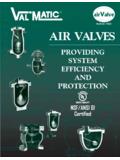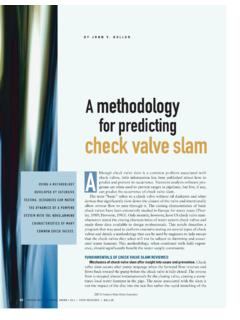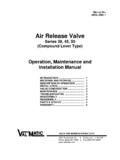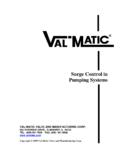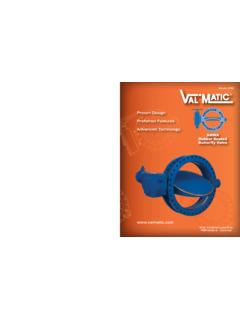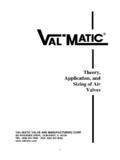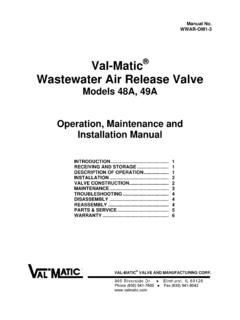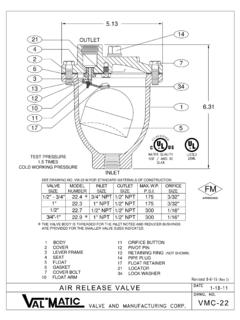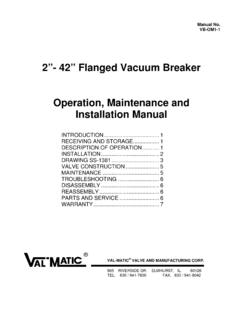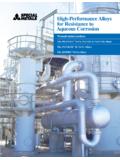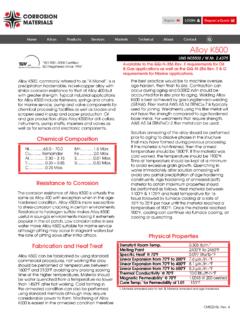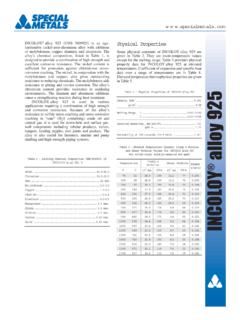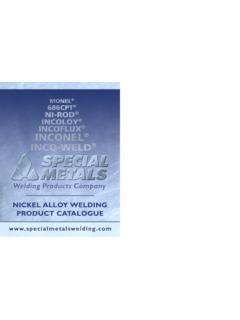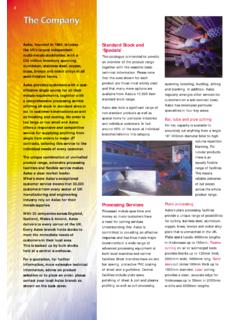Transcription of Chemical Resistance Guide 12-10-13 - Val-Matic …
1 1 Chemical Resistance Guide for Valves Val-Matic VALVE AND MANUFACTURING CORP. 905 RIVERSIDE DRIVE, ELMHURST, IL 60126 TEL. (630) 941-7600 FAX. (630) 941-8042 Copyright 2013 Val-Matic Valve and Manufacturing Corp. 2 PURPOSE This Guide was developed by Val-Matic Valve and Manufacturing Corporation as a convenience to its customers and should be utilized only as a Guide for the selection of valve materials. Mixtures and other Chemical concentrations of chemicals are beyond the scope of this Guide . Performances of materials in existing systems also offer valuable information in predicting valve performance. Information given in the table consists of the maximum recommended temperature for the listed material in F or a letter designating: A = resistant under normal conditions B = conditional Resistance , review performance C = not recommended blank = no data available Val-Matic offers no warranty or representation as to the accuracy or completeness of these tables.
2 Use of these tables should be made under the direction of trained engineers or design professionals exercising independent judgment regarding the suggested use of the valve types and materials. 3 General Properties of Elastomers and Plastics Buna-N (Nitrile, NBR), or copolymer of butadiene and acrylonitrile has excellent Resistance to petroleum products, lubricants, and water over a wide temperature range of 50 to 200 degrees F. Nitrile is a widely used elastomer for hydraulic system o-rings. Buna-N does not have good Resistance to outdoor exposure to ozone, sunlight, or weather. Neoprene (Chloroprene, CR) is one of the first commercially available elastomers and is low in cost. Neoprene is unique with its moderate Resistance to both petroleum products and oxygen over a wide temperature range of 50 to 200 degrees F. Neoprene is a widely used elastomer for seals with exposure to refrigerants, petroleum oils, and mild acids.
3 Neoprene does not have good Resistance to solvents such as MEK and acetone. EPDM (Ethylene Propylene Diene Monomer) exhibits strong Resistance to ozone, certain hydraulic fluids, brake fluids, steam, and water over a wide temperature range of 50 to 250 degrees F. EPDM has gained increased use in the municipal water industry because of its Resistance to water disinfected with chloramines. It has poor Resistance to petroleum-based fluids, mineral oils, and solvents. Viton (Fluorocarbon, FKM) possesses a strong Resistance to chemicals and air at high temperature applications to 400 degrees F. Viton is high in cost and is used in aircraft, automotive applications where Resistance to petroleum oils, silicone fluids, and acids is needed. Viton also has superior chloramine Resistance for drinking water applications. Hypalon (Chlorosulfonated Polyethylene, CSM) is similar to neoprene in Chemical Resistance and useful in the range of 50 to 200 degrees F for acid and ozone Resistance .
4 Natural Rubber (Natural Polyisoprene, NR) is produced from various plants with excellent wear properties and Resistance to brake fluid, water, sewage, but not petroleum products. Natural rubber is economical and commonly used for lining trucks, railroad cars, and valves for abrasion Resistance . Natural rubber has been mostly replaced by synthetic elastomers for industrial seals. RPTFE (Reinforced Polytetrafluoroethylene), is a compound with a percentage of fiber glass or filler material to provide additional strength, stability and Resistance to abrasive wear, cold flow and permeation in molded seats. Reinforcement such as glass fiber permits applications at higher pressures and temperatures than unfilled PTFE. RPTFE should not be used in applications that attack glass, such as hydrofluoric acid and hot /strong caustics. Temperature range for RPTFE is -320 to 450 F. Nylon (Polyamide) is one of the first thermoplastics used as rubber cords, belts, sports apparel, and structural parts such as valve bearings.
5 Nylon has excellent Resistance to oils and solvents, but limited Resistance to alkalis and Acids. Its application is limited to a maximum temperature of 250 degrees F. PEEK (Poly Ether Ether Ketone) is a high performance engineered thermoplastic. PEEK is considered a premium seat material that offers a unique combination of Chemical , mechanical, electrical and thermal properties. Its excellent water/ Chemical Resistance makes it unaffected by continuous exposure to hot water/steam. PEEK is good for temperatures of -70 F to 500 F. PEEK is non-porous, high strength for high pressure applications and is suitable for high corrosion environments. 4 Devlon Devlon is among the toughest and hardest wearing thermoplastic available. It was designed for the valve industry as a seat material to provide a wide temperature and pressure range. Its Resistance to Chemical and corrosion attack is well documented, due to its use in various applications throughout most industries, such as oil and gas.
6 Pressures up to 6000psi and temperatures from -50 F to 250 F can be obtained. Chemraz A high temperature perfluoroelastomer with superior physical properties and Chemical Resistance . The compound excels in dynamic applications and exhibits unparalleled performance in high temperature steam. Temperature range is from 0 F to 600 F. Markez is a high performance perfluoroelastomer compound that offers a broad Chemical and temperature Resistance up to 600 F. For demanding sealing applications, in various industries, like Petrochemical and where harsh solvents are required. The temperature range is -5 F to 600 F. Aflas is a fluoroelastomer compound that has excellent heat Resistance with continues service temperature capability of 450 F. and good Chemical Resistance , including Resistance to strong acids and bases. Aflas also has excellent oil Resistance . General Properties of Metals Carbon Steel has very good mechanical properties, good Resistance to stress corrosion and sulfides.
7 Carbon steel has high and low temperature strength, is very tough, and has excellent fatigue strength. Steel can be easily cast or forged in making ANSI Pressure-Temperature rated valve bodies or structural parts for applications up to 850 degrees F. Nickel is an elemental metal common for Chemical processing applications because of its corrosion Resistance . Nickel is used for valve seats because of its good welding ability and lack of brittleness. Gray Iron is an alloy of iron, carbon and silicon; easily cast; and has good pressure tightness in the as-cast condition. Because gray iron contains flakes of graphite, it is brittle but exhibits excellent dampening properties and is easily machined. It is standard material for bodies and bonnets of ASME Class 125 and 250 valves. Gray iron has corrosion Resistance that is improved over steel in certain environments. Ductile Iron has a Chemical composition similar to gray iron, but special treatment during the casting process enhances its metallurgical graphite structure to yield higher mechanical properties and improved ductility similar to steel.
8 It is standard material for bodies and bonnets of ASME Class 150 and 300 valves Bronze is one of the first copper alloys developed in the bronze age and is generally accepted as the industry standard for pressure-rated bronze valves and fittings. Bronze has a higher strength than pure copper, is easily cast, has improved machinability, and is very easily joined by soldering or brazing. Bronze is very resistant to pitting corrosion, with general Resistance to most chemicals less than that of pure copper. Historically, bronze alloys have contained lead to improve machinability and leak tightness, but recently are being improved with the release of lead-free alloys for drinking water applications. 5 Aluminum Bronze is the most widely accepted disc material used in many valves for liquid service. Aluminum bronze is heat treatable and has the strength of steel. Formation of an aluminum oxide layer on exposed surfaces makes this metal very corrosion resistant.
9 304SS is basic 18% chromium, 8% nickel austenitic stainless steel commonly used for valve trim. Its .08 max carbon content reduces intergranular corrosion usually associated with carbide precipitation that can occur during welding. It offers excellent Resistance to a wide range of corrosives and atmospheric exposures. 17-4 PH SS is similar to 304 SS except it is capable of being heat treated, doubling its strength and making it a good choice for high performance valve trim. 17-4 PH withstands corrosive attack better than any of the 400 series stainless steels and in most conditions its corrosion Resistance closely approaches that of 300 series stainless steel. 17-4 PH is primarily used as a stem material for high pressure butterfly and ball valves. 316SS is chemically similar to 304 SS except with the addition of molybdenum providing better corrosion and pitting Resistance and higher strength at elevated temperatures.
10 It is non-magnetic with greater ductility than 400SS. 316SS has excellent corrosion Resistance in a wide range of environments, is not susceptible to stress corrosion cracking, and is not affected by heat treatment. Most common uses in valves are stem, body and ball materials. Nitronic 60 is a high-performance stainless steel alloy with excellent gall and wear Resistance with corrosion Resistance falling between 304SS and 316SS but with approximately twice the yield strength. Nitronic 60 is used for valve trim when extreme wear Resistance or strength is required. Monel is a nickel-copper alloy used primarily as interior trim on valves. It is one of the most specified materials for corrosion Resistance to sea and salt water. Monel is also very resistant to strong caustic solutions. Inconel is nickel-copper-molybdenum alloy with excellent corrosion Resistance in a wide range of corrosive media and is especially resistant to pitting and crevice corrosion.
